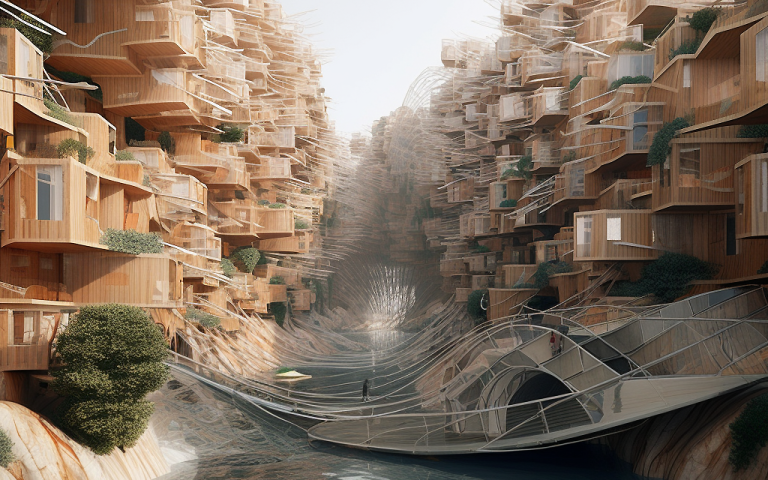 Research
Research

Subject
On the Architectural Rationality of Connectionist Design
First and second supervisors
Abstract
The past decade has witnessed the rise of connectionism, which has led to intensive attempts in the architectural research community to form a novel digital design paradigm created using the probabilistic computational mechanisms of deep neural networks. This thesis project aims at investigating the conceptual shift of architectural rationality in the emerging modes of connectionist design, and tries to relate this shift to the history of architectural theory. It argues that the rise of connectionism is a fundamental alternative to the ‘symbolic’ view of computation, as well as an alternative to modern design thinking. More generally, connectionism is the alternative scientific method to traditional ‘rationality,’ where design is addressed through ‘rule-based-problem-solving’ that usually employs formal systems. The first half of the thesis contextualises the rise of connectionist design and discusses the development of the architectural relevance of the probability theory that connectionism relies on. The second half of the thesis is an extended case study on the selected connectionist design projects. It tries to generalise the projects and accordingly develop a critical discussion on type, style and collective design thinking. Inspired by the operational nature of autoencoders, the discussion defines the connectionist concept of ‘latent space’ as a quintessential data-compression technology, of which types and styles become the ideal residents. The differentiable nature of ‘latent space’ may allow designers to consciously intervene in the construction of design schemata in an encoded, vectorial field of artefact creation.
Biography
Sheng-Yang (William) Huang is a PhD Candidate, a Tutor for both Urban Design MArch RC18 at The Bartlett, UCL and the postgraduate Landscape Urbanism at the AA. William was an Adjunct Lecturer in digital design and fabrication for Cheng Shiu University in Taiwan and has been invited to lecture for several academic institutions and organisations including Wuppertal University in Germany, People’s Government of Qingshan District Wuhan City, Beijing Forestry University and Shanghai Tongji Urban Planning and Design Institute in China. William completed a BArch (THU) and an MArch (NCTU) in Taiwan, and received the Architecture and Digital Theory MRes with distinction from The Bartlett with his studies on the theory of material-based computational design. Currently, William's principal research interest is connectionist design and the relevant architectural theories.
Publications
- Huang, S.-Y., Llabres-Valls, E., Jiang, M., Wang, Y., Chen, F. Deep Eco-Conditioning: Intermodal Design Reasoning of Spatial Connectivity (working paper)
- Llabres-Valls, E., Huang, S.-Y., Tabony, A., 2021. Damascus House: A Deep Simulacrum of Islamic Architecture. ACADIA 2022: Hybrids & Haecceities, Philadelphia, PA (working paper)
- Huang, S.-Y., On the Architectural Responses to the Paradigm Shifts in Artificial Intelligence., ICIDAE 2022 Interactive Design, Architecture and Engineering, Warsaw, Poland (abstract accepted)
- Huang, S.-Y., Radical Matter: A Survey of the Approaches to the Material Responsiveness Enhancements for Architectural Adaptations., Engineering-Architecture-Urban Planning Symposium – WMCAUS 2022, Prague, Czech (abstract accepted)
- Huang, S.-Y., Llabres-Valls, E., Jiang, M., W ang, Y., Chen, F. 2021. Deep Tuning of Urban Ecology., 2021 LATSIS Symposium-Open forum: Deep City: Climate Crisis, Democracy and the Digital, EPFL, Lausanne, Switzerland
- Llabres-Valls, E., Huang, S.-Y., Fluker, Z. F., 2021. Expanded Ecologies for a Capital-driven Earth System. In: Monacella, R., Keane, B.(eds.) Studio Ecologies: Designing Landscape Architectural Education for Unpredictable Futures. Routledge.
- Hsu, P.H., Huang, S.-Y. & Lin, B.S. 2013. Smar t-device-based Augmented Reality (SDAR) Models to Support Interior Design: Rethinking “Screen” in Augmented Reality., Advances in Visual Informatics (pp. 539–548). Springer, Cham.
Funding
Government Scholarship to Study Abroad by the Ministry of Education, Republic of China (Taiwan)
Links
Image: by Sheng-Yang Huang
 Close
Close

